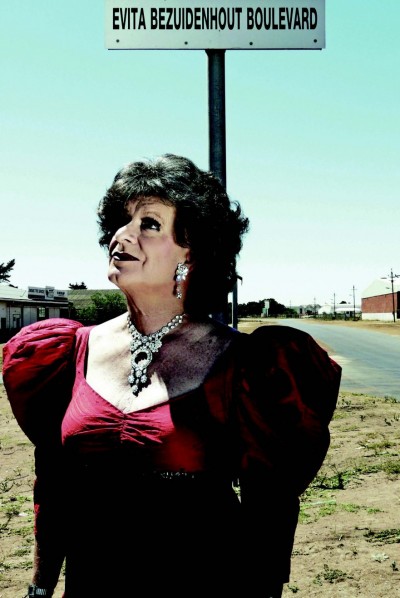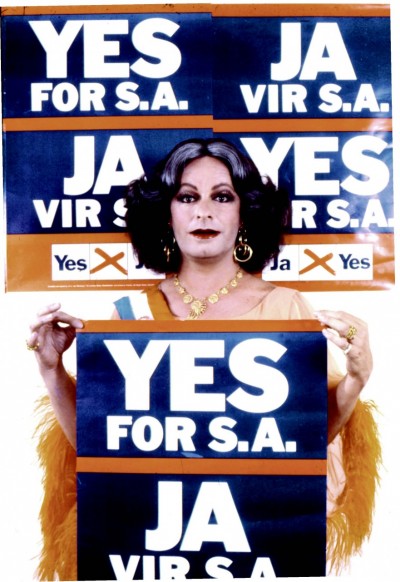Suzy Bell speaks to Pieter-Dirk Uys, who convinced his muse, Evita Bezuidenhout, to publish a retro-cool diary, which he calls the BlackBessie.
Looking at the photographs in BlackBessie it is clear that as Pieter-Dirk Uys working through the art persona of Evita, you are a serious performance artist playing with gender roles, hybridity and popular culture. As Evita, you have effectively erased your identity for the sake of art and for wider socio-political meaning. Do you see yourself in the role of the performance artist as the character, Evita?
I am an actor. My job is to erase my identity so that the character I play is convincing. My job with Evita is complex: she has to be so real that the women recognise the woman and the men forget the man. She cannot ever be a cartoon of women like Dame Edna. The fact that she has survived since 1978, not just as a stage persona, but as a “farce to be reckoned with”, is only because she is driven and fed by the real politics of the day — the homelands dissolved and so did hers. She had to retire. If Zuma appoints her as SA Ambassador to Mongolia she must go — and I must toe that line. Evita is now so established — like the Queen Mother — that the creation of Bambi Kellermann, her sister, has been an important balance. Evita has no sense of humour or flair for irony; Bambi has both. Evita doesn't use bad language; Bambi thrives on incorrectness. And as for Evita stealing all the attention? That's the proof of the success of the process.

FAME AT LAST: Evita in her hometown of Darling being honoured with a street name, Evita Bezuidenhout Boulevard. Picture by Stephan Hurter
When you first conceptualised Evita, what was your initial thinking in the need to create her?
1978. Bad times. Censorship. Info scandal. I'd been asked to write a weekly column in the Sunday Express and created a woman who once a month, from her patio in Pretoria, gossiped about the scandals under the table of PW's democracy. One day the editor called me in about this “Evita of Pretoria”. "How can she say the things we cannot print?" In 1981, she then appeared in the boere-baroque costume on stage in “Adapt or Dye”. Just the right moment. She was the Eva Peron of the National Party, condemning them with passionate praise and hating me with purple prose. The media loved her. And the fact that it was against the law for a man to wear woman's clothing, made it even more appealing.

BRAAING IN HEELS: Evita in her backyard preparing for a typical South African Sunday braai. Unaccredited picture as published in BlackBessie
Evita has challenged audiences to think in new and unconventional ways, breaking conventions and taboos. What do you think made Evita become such a potent persona?
She must be entertaining, never preachy. She must reflect the fear of the audience. She must trash the expectations and surprise with her arrogant stupidity as the perfect and familiar supporter of the NP. Her style of dress, her use of language, her holier-than-thou attitude. Everyone seems to have a Tannie Evita in their lives — a wife, a mother-in-law, a teacher … and so just because she didn't exist, doesn't mean she wasn't real to most South Africans.

YA/NEE: Evita Bezuidenhout as a highly politicised young woman in the Republic of South Africa. Picture by Ruphin Coudyzer
Is the koeksister Evita’s most potent cultural weapon?
After she left the “diplomatic corpse”, cooking was the automatic alternative. And the koeksister was the obvious weapon of choice. It is also not truly Afrikaans, but high-jacked from the Muslim Malay culture.
What are the key socio-political issues you feel Evita has successfully addressed?
She is a designer-democrat and mouths the right words. She is terrified of being called a racist and bends over blackwards. She has three black grandchildren, a fact which forces her to address issues she would rather ignore: HIV, rape, sex, education, her son being gay, voting, learning the Xhosa words of the National Anthem. She is also an optimist — and my most important contribution is performing her in such a way that while we expose all the negative in our daily politics, audiences must leave with optimism and an excitement for the future. Nelson Mandela as President had a framed picture on his desk of himself — and Evita Bezuidenhout. Hello?

DOCTOR, DOCTOR: Evita visits her local sangoma for divine intervention. Picture by Ruphin Coudyzer
What are Evita’s major achievements? Like the swimming pool in Darling, tell me more about the success of the Darling Trust.
The Evita Bezuidenhout Boulevard can be seen on the GPS and Google Earth. She is the Mother of the Community. The pool is her passion and took eight years to build. Thanks to the generosity of Sabina Plattner who financed the project, as well as the people of Darling who would have weekend cake sales to raise R130 towards the cost. Evita gets involved with voter education (www.epp.org.za) and people listen when she explains the secret ballot, the sacred vote, the Madiba legacy. The Trust now has 80 small people between the ages of three and five in the ECD Centre, learning. Tannie's picture is on the wall.
Who is Evita’s stylist and where does she get her glam outfits from?
She thanks her son's friend Moff de Bruyn. I thank Chris Levin, Errol Arendz, Vedemme and the Oriental Plaza in Joburg.
What does Evita think of Lady Gaga’s outrageous outfits? Would Evita like to meet lady Gaga and why, or why not? Or who would Evita like to meet that she has not yet met and why?
She would only focus on something her grandchildren point out, so maybe she has gasped at Gaga's gaga. She is suspicious of anyone who might look like a man in a dress — she finds that very unAfrikaans and sometimes I think Gaga might give that impression. Evita would like to meet Sarah Palin — because she's already met everyone else who is more important.
The other personae, like Evita’s sons De Kock and Izan, and her daughter, Billie-Jeanne, are clearly defined characters. Why don’t they, as performance artists, come out more often?
They would only feature within Evita's world as her children. With “Evita's Kossie Sikelela” and the shoot of the cover of the cookbook both De Kock and Billie-Jeanne reappeared after a 20-year absence.

TWINSETS & CHAINS: De Kock Bezuidenhout’s outlandish twin brother, Izan. Picture by Richard Cuttler
How important is it that Evita makes hard copy diaries/organisers retro-cool again? Has she sent her diaries to any famous people? Sophia Loren, Madiba, Winnie?
There is a logic to keeping paper and pen ready for the day when a sun flare renders all computers and cell phones obsolete. The BlackBessie has also succeeded in the most important aspect: to put a smile on the face of the holder. That's Evita's legacy — laughter. The fact that Madiba has had so many good laughs at her expense, proves the reason for her existence. And yes, Sophia loves the BlackBessie and the pictures and did remark: “Your Evita is starting to look a lot like me!”
 SLiPStellenbosch Literary Project
SLiPStellenbosch Literary Project